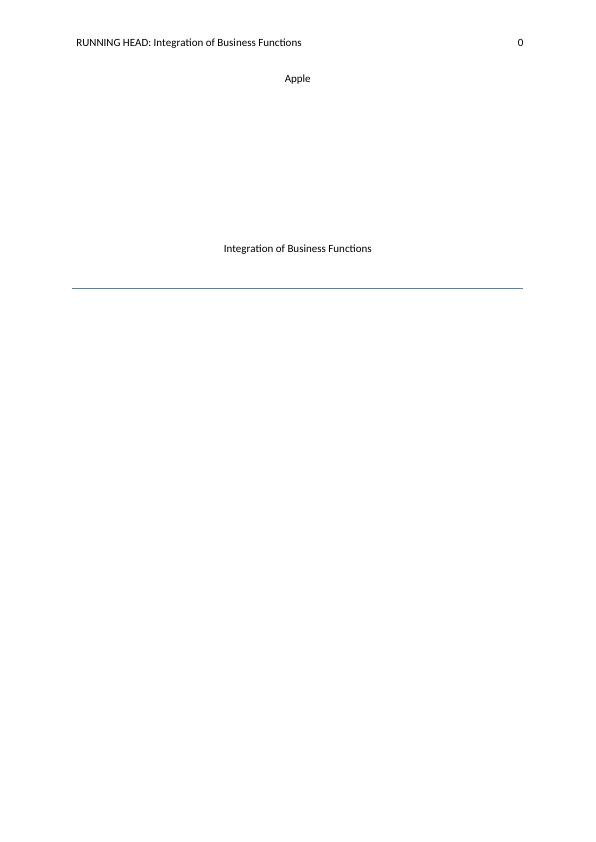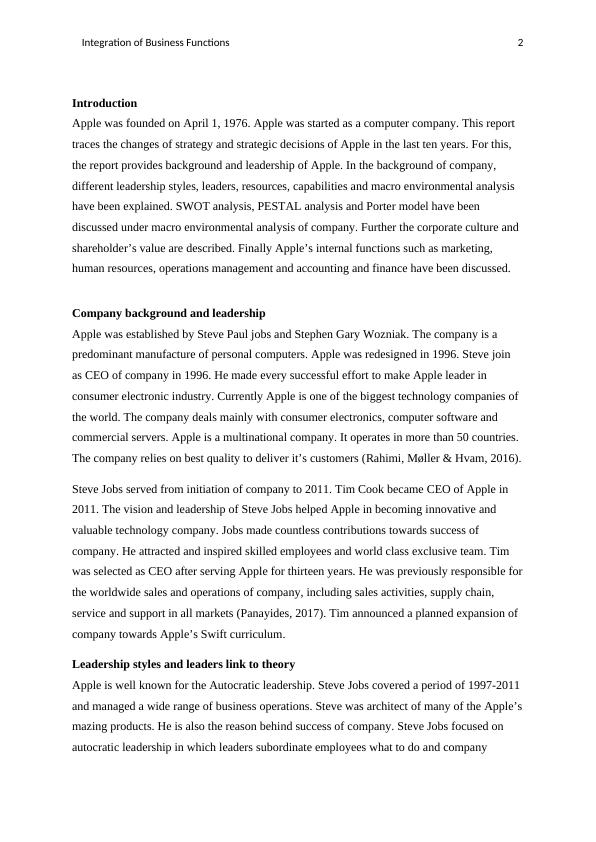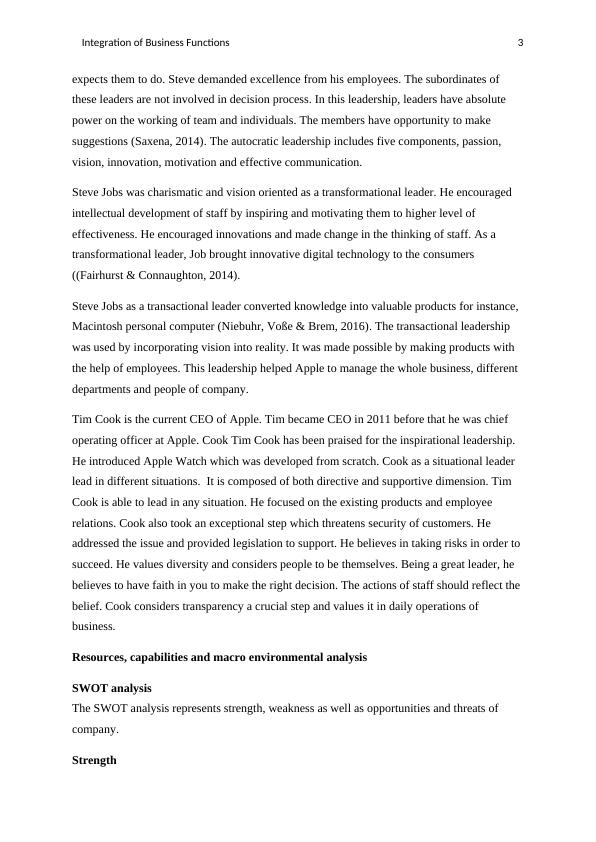Integration of Business Functions: A Case Study of Apple
Added on 2023-06-12
16 Pages4871 Words476 Views
RUNNING HEAD: Integration of Business Functions 0
Apple
Integration of Business Functions
Apple
Integration of Business Functions

Integration of Business Functions 1
Contents
Introduction...........................................................................................................................................2
Company background and leadership....................................................................................................2
Leadership styles and leaders link to theory......................................................................................2
Resources, capabilities and macro environmental analysis................................................................3
SWOT analysis..............................................................................................................................3
PESTEL analysis...........................................................................................................................5
Porter model..................................................................................................................................6
Corporate culture...................................................................................................................................7
Shareholder’s value...............................................................................................................................8
Internal business functions....................................................................................................................9
Marketing..........................................................................................................................................9
Human resources.............................................................................................................................10
Operations management..................................................................................................................11
Accounting and finance...................................................................................................................11
Conclusion...........................................................................................................................................12
References...........................................................................................................................................13
Contents
Introduction...........................................................................................................................................2
Company background and leadership....................................................................................................2
Leadership styles and leaders link to theory......................................................................................2
Resources, capabilities and macro environmental analysis................................................................3
SWOT analysis..............................................................................................................................3
PESTEL analysis...........................................................................................................................5
Porter model..................................................................................................................................6
Corporate culture...................................................................................................................................7
Shareholder’s value...............................................................................................................................8
Internal business functions....................................................................................................................9
Marketing..........................................................................................................................................9
Human resources.............................................................................................................................10
Operations management..................................................................................................................11
Accounting and finance...................................................................................................................11
Conclusion...........................................................................................................................................12
References...........................................................................................................................................13

Integration of Business Functions 2
Introduction
Apple was founded on April 1, 1976. Apple was started as a computer company. This report
traces the changes of strategy and strategic decisions of Apple in the last ten years. For this,
the report provides background and leadership of Apple. In the background of company,
different leadership styles, leaders, resources, capabilities and macro environmental analysis
have been explained. SWOT analysis, PESTAL analysis and Porter model have been
discussed under macro environmental analysis of company. Further the corporate culture and
shareholder’s value are described. Finally Apple’s internal functions such as marketing,
human resources, operations management and accounting and finance have been discussed.
Company background and leadership
Apple was established by Steve Paul jobs and Stephen Gary Wozniak. The company is a
predominant manufacture of personal computers. Apple was redesigned in 1996. Steve join
as CEO of company in 1996. He made every successful effort to make Apple leader in
consumer electronic industry. Currently Apple is one of the biggest technology companies of
the world. The company deals mainly with consumer electronics, computer software and
commercial servers. Apple is a multinational company. It operates in more than 50 countries.
The company relies on best quality to deliver it’s customers (Rahimi, Møller & Hvam, 2016).
Steve Jobs served from initiation of company to 2011. Tim Cook became CEO of Apple in
2011. The vision and leadership of Steve Jobs helped Apple in becoming innovative and
valuable technology company. Jobs made countless contributions towards success of
company. He attracted and inspired skilled employees and world class exclusive team. Tim
was selected as CEO after serving Apple for thirteen years. He was previously responsible for
the worldwide sales and operations of company, including sales activities, supply chain,
service and support in all markets (Panayides, 2017). Tim announced a planned expansion of
company towards Apple’s Swift curriculum.
Leadership styles and leaders link to theory
Apple is well known for the Autocratic leadership. Steve Jobs covered a period of 1997-2011
and managed a wide range of business operations. Steve was architect of many of the Apple’s
mazing products. He is also the reason behind success of company. Steve Jobs focused on
autocratic leadership in which leaders subordinate employees what to do and company
Introduction
Apple was founded on April 1, 1976. Apple was started as a computer company. This report
traces the changes of strategy and strategic decisions of Apple in the last ten years. For this,
the report provides background and leadership of Apple. In the background of company,
different leadership styles, leaders, resources, capabilities and macro environmental analysis
have been explained. SWOT analysis, PESTAL analysis and Porter model have been
discussed under macro environmental analysis of company. Further the corporate culture and
shareholder’s value are described. Finally Apple’s internal functions such as marketing,
human resources, operations management and accounting and finance have been discussed.
Company background and leadership
Apple was established by Steve Paul jobs and Stephen Gary Wozniak. The company is a
predominant manufacture of personal computers. Apple was redesigned in 1996. Steve join
as CEO of company in 1996. He made every successful effort to make Apple leader in
consumer electronic industry. Currently Apple is one of the biggest technology companies of
the world. The company deals mainly with consumer electronics, computer software and
commercial servers. Apple is a multinational company. It operates in more than 50 countries.
The company relies on best quality to deliver it’s customers (Rahimi, Møller & Hvam, 2016).
Steve Jobs served from initiation of company to 2011. Tim Cook became CEO of Apple in
2011. The vision and leadership of Steve Jobs helped Apple in becoming innovative and
valuable technology company. Jobs made countless contributions towards success of
company. He attracted and inspired skilled employees and world class exclusive team. Tim
was selected as CEO after serving Apple for thirteen years. He was previously responsible for
the worldwide sales and operations of company, including sales activities, supply chain,
service and support in all markets (Panayides, 2017). Tim announced a planned expansion of
company towards Apple’s Swift curriculum.
Leadership styles and leaders link to theory
Apple is well known for the Autocratic leadership. Steve Jobs covered a period of 1997-2011
and managed a wide range of business operations. Steve was architect of many of the Apple’s
mazing products. He is also the reason behind success of company. Steve Jobs focused on
autocratic leadership in which leaders subordinate employees what to do and company

Integration of Business Functions 3
expects them to do. Steve demanded excellence from his employees. The subordinates of
these leaders are not involved in decision process. In this leadership, leaders have absolute
power on the working of team and individuals. The members have opportunity to make
suggestions (Saxena, 2014). The autocratic leadership includes five components, passion,
vision, innovation, motivation and effective communication.
Steve Jobs was charismatic and vision oriented as a transformational leader. He encouraged
intellectual development of staff by inspiring and motivating them to higher level of
effectiveness. He encouraged innovations and made change in the thinking of staff. As a
transformational leader, Job brought innovative digital technology to the consumers
((Fairhurst & Connaughton, 2014).
Steve Jobs as a transactional leader converted knowledge into valuable products for instance,
Macintosh personal computer (Niebuhr, Voße & Brem, 2016). The transactional leadership
was used by incorporating vision into reality. It was made possible by making products with
the help of employees. This leadership helped Apple to manage the whole business, different
departments and people of company.
Tim Cook is the current CEO of Apple. Tim became CEO in 2011 before that he was chief
operating officer at Apple. Cook Tim Cook has been praised for the inspirational leadership.
He introduced Apple Watch which was developed from scratch. Cook as a situational leader
lead in different situations. It is composed of both directive and supportive dimension. Tim
Cook is able to lead in any situation. He focused on the existing products and employee
relations. Cook also took an exceptional step which threatens security of customers. He
addressed the issue and provided legislation to support. He believes in taking risks in order to
succeed. He values diversity and considers people to be themselves. Being a great leader, he
believes to have faith in you to make the right decision. The actions of staff should reflect the
belief. Cook considers transparency a crucial step and values it in daily operations of
business.
Resources, capabilities and macro environmental analysis
SWOT analysis
The SWOT analysis represents strength, weakness as well as opportunities and threats of
company.
Strength
expects them to do. Steve demanded excellence from his employees. The subordinates of
these leaders are not involved in decision process. In this leadership, leaders have absolute
power on the working of team and individuals. The members have opportunity to make
suggestions (Saxena, 2014). The autocratic leadership includes five components, passion,
vision, innovation, motivation and effective communication.
Steve Jobs was charismatic and vision oriented as a transformational leader. He encouraged
intellectual development of staff by inspiring and motivating them to higher level of
effectiveness. He encouraged innovations and made change in the thinking of staff. As a
transformational leader, Job brought innovative digital technology to the consumers
((Fairhurst & Connaughton, 2014).
Steve Jobs as a transactional leader converted knowledge into valuable products for instance,
Macintosh personal computer (Niebuhr, Voße & Brem, 2016). The transactional leadership
was used by incorporating vision into reality. It was made possible by making products with
the help of employees. This leadership helped Apple to manage the whole business, different
departments and people of company.
Tim Cook is the current CEO of Apple. Tim became CEO in 2011 before that he was chief
operating officer at Apple. Cook Tim Cook has been praised for the inspirational leadership.
He introduced Apple Watch which was developed from scratch. Cook as a situational leader
lead in different situations. It is composed of both directive and supportive dimension. Tim
Cook is able to lead in any situation. He focused on the existing products and employee
relations. Cook also took an exceptional step which threatens security of customers. He
addressed the issue and provided legislation to support. He believes in taking risks in order to
succeed. He values diversity and considers people to be themselves. Being a great leader, he
believes to have faith in you to make the right decision. The actions of staff should reflect the
belief. Cook considers transparency a crucial step and values it in daily operations of
business.
Resources, capabilities and macro environmental analysis
SWOT analysis
The SWOT analysis represents strength, weakness as well as opportunities and threats of
company.
Strength

End of preview
Want to access all the pages? Upload your documents or become a member.
Related Documents
Management and Operations: Roles of Leader and Manager at Apple Inc.lg...
|11
|3218
|1
Organisations and Quality Of Leadership Skillslg...
|10
|2848
|16
Leadership Style of Tim Cook Article 2022lg...
|9
|2709
|28
Corporate Culture Issue - PDFlg...
|17
|4637
|174
Leading People in Creative Teams SHR0796lg...
|13
|940
|271
Management Attribute and Skills Analysis 2022lg...
|4
|676
|27
